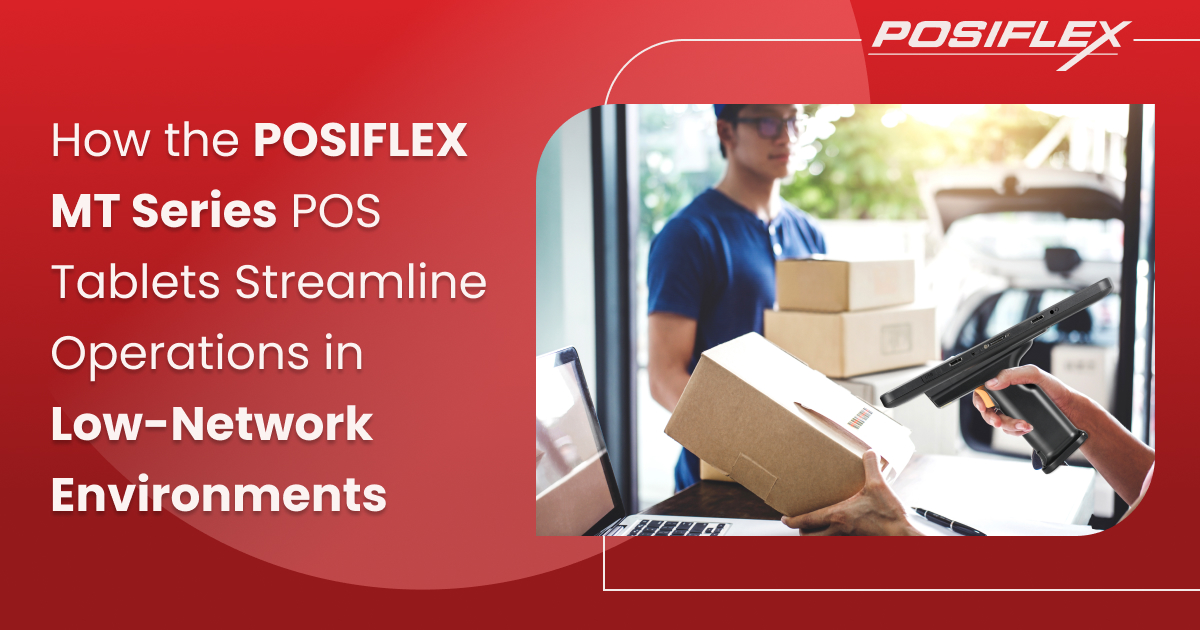
The rugged hardware of the POSIFLEX MT Series Tablet POS Systems makes it ideal for demanding environments, where a non-rugged device is unlikely to perform optimally long term.
Already, in our last blog, Why Tablet POS is the Future: A Look at the POSIFLEX MT Series, we established that:
We also discussed that the large backlight TFT LCD screen (8” for the Android POS and 10.1” for the Windows POS) offers 800×1280 resolution and 300-nit brightness. The display properties signal that the tablet POS devices are energy-efficient and ensure crisp visual quality.
Interestingly, many heavy-duty operations facilities, where the tablet’s resilience shines, often are low-network zones.
Warehouses, manufacturing facilities, 3PL (third-party logistics) establishments, cold storage units, and dark stores are some of the key businesses characterised by harsh environments and poor network connectivity.
In this blog, let’s explore the features enabling the MT Series hybrid POS (tablets) to thrive even without a steady internet connection!
Inventory tracking and inventory audits are among the key tasks tackled by Tablet POS systems in the industries mentioned above. However, in such closed areas, riddled with tall and deep industrial-grade shelves, manual tracking is challenging if not impossible. Therefore, maximising the scanning range of the mobility device is vital for efficient inventory management.
The range of the built-in 2D barcode scanner is potentially enhanced by the hybrid POS (tablet) system’s connectivity features. The features are Wi-Fi 5/6 and Bluetooth 5.0/5.2, which are among the most powerful Wi-Fi and Bluetooth versions, respectively.
Given that the users may have to gather a vast amount of inventory details, the storage and memory of the tablet prove invaluable. The RAM and storage capacity ensure that the data, scanned or otherwise captured, in poor-network zones, registers successfully in the device, without causing auto-deletion or system lag.
The Android Tablet POS systems from the POSIFLEX MT Series feature 4 GB of RAM in models with 64 GB of storage, and 8 GB of RAM in devices that have a storage capacity of 128 GB. On the other hand, the models specifically built for the Windows 11 Operating System have 8GB of RAM and two storage capacity options: 64GB and 128GB.
In both versions, there is a provision for a TF card slot, offering expandable storage of up to 512 GB.
The Tablet POS system’s Operating Systems are also vital for processing information offline. Both the Android 13 and Windows 11 avatars of the tablets drive peak performance, thanks to the ISA of their respective processors, which ensures compatibility with the corresponding Operating System.
To elaborate, what makes the MT Series tablets Android 13-compatible is their MediaTek MT8786 processor, which features the RISC ISA variant. Alternately, the Windows 11 tablets are powered by the Intel Elkhart Lake processor’s x86 ISA variant.
Along with its processor and storage capacity, the tablet POS systems of the MT series can efficiently carry out their tasks offline thanks to the Android 13 OS with Google Mobile Services (GMS). The OS enables Android POS apps to continue working securely, using local data until network service resumes.
Similarly, the Windows 11 versions of the hybrid POS (tablets) keep POS software running offline, enabling uninterrupted transaction logging and stock management. We have, in our blog, Top Benefits of Using a Tablet POS: How POSIFLEX’s MT Series Can Transform Operations, discussed how this edge data can later be transferred to the Cloud (for historical data analysis and other Analytics-centric tasks) by leveraging the tablet’s docking station.
On a different note, apart from the display’s energy-saving features, the processors of the tablets also ensure optimal energy use through optimal information processing, thereby setting the device up for long-lasting performance.
Curious to know more about the hybrid POS (tablets)? Contact us now, and one of our executives will get in touch with you soon!
Copyright © 2025 Posiflex Technology, Inc. All Rights Reserved.
WhatsApp us